The next pre-reform follis type of Alexius is much scarcer.
 This piece: 25-23 mm. 3.68 grams.
This piece: 25-23 mm. 3.68 grams.
Facing bust of the Virgin Mary, MP ΘV either side
holding medallion of Christ
Alexius standing holding labarum and globus cruciger
AΛЄ ... for Alexius, beginning at 7:30.
Sear 1909
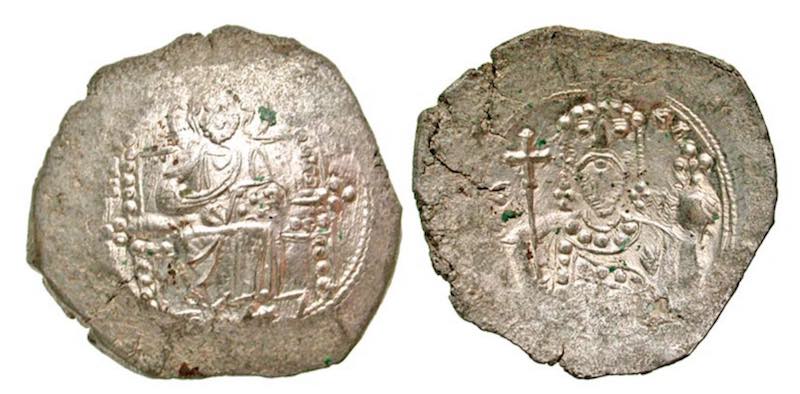
The new post-reform low-denomination coins. Prior to the reform the low-denomination coins were flat and only the electrum coins and the miliaresion were cup-shaped. Alexius added in a cup-shaped "billon aspron trachy" with a small amount of silver in its alloy, valued at 1/48 of a hyperpyron.
This example: 26-24 mm and 4.28 grams. Unusually silvery.
Christ enthroned facing. Half-length figure of Alexius facing. Sear 1918.
Most coins of this denomination look like copper. Alexius, and only Alexius, has some that still look silvery.
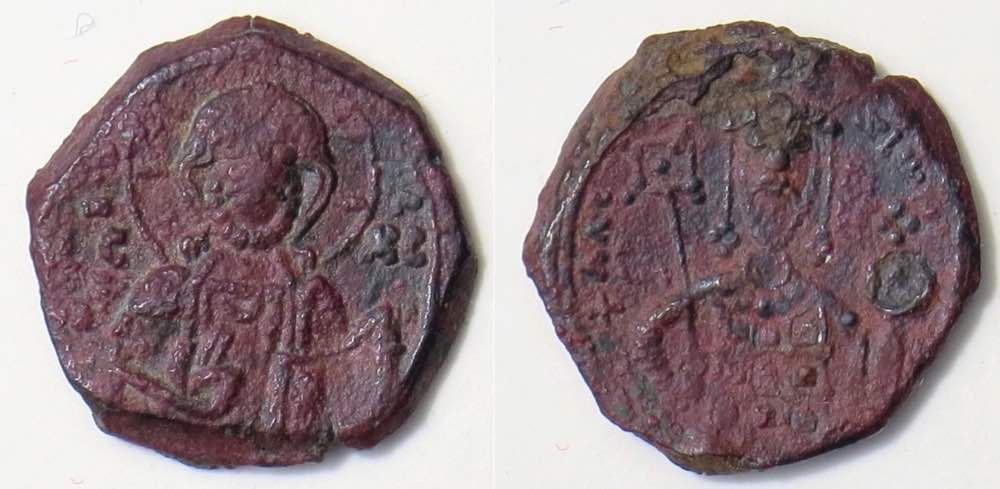 A new copper "tetarteron". The previous follis was a larger coin of c. 24 mm and c. 6 grams. It was replaced by the smaller tetarteron.
A new copper "tetarteron". The previous follis was a larger coin of c. 24 mm and c. 6 grams. It was replaced by the smaller tetarteron.
Alexius I, 1081-1118. Tetrarteron.
This piece: 18 mm. 3.93 grams.
Half-length bust of Christ facing, IC XC on either side. The reverse has a half-length bust of Alexius facing. AΛЄ beginning "Alexius" to his left.
Sear 1920.
Prior to the reform each emperor issued only one or two types of copper coins, In contrast, the new tetarteron denomination comes with numerous types and the new half-terarteron is distinguishable from them only by being smaller.
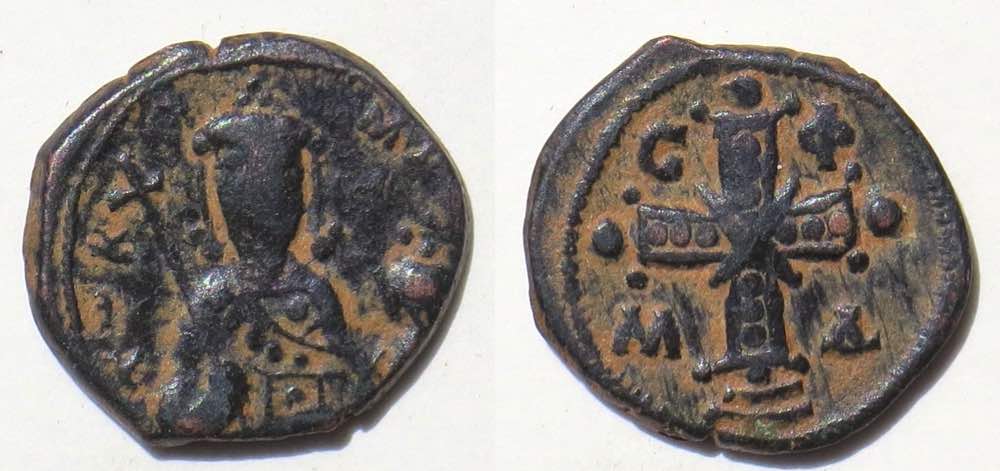 Here is a second, common, type of the new tetarteron
Here is a second, common, type of the new tetarteron
Alexius I, 1081-1118. Tetrarteron.
This piece: 20-18 mm. 3.71 grams.
Emperor facing with cruciform scepter and globus cruciger
Reverse with, in the quadrants of a jeweled cross:
C Φ (The "C" is a lunate "S" (sigma))
ΣΤAYΡЄ ΦΥΛATTЄ "O Cross, Protect"
AΛ Δ [The "AΛ" for "Alexius" looks like an "M"--the crossbar of the A is always missing]
AΛЄΞION ΔЄCΠOTH. "May the cross protect (or, O Cross, protect) Alexius Despot"
History and Coins Outline:
Byzantine Emperors 1059-1118
|
Emperor
|
Dates |
Relationship to the previous emperor |
Gold coins |
Silver |
Copper coins
Anonymous Classes
Named types |
Constantine X and
his wife Eudocia |
1059-1067 |
None. He was a relative of the patriarch who was
selected when the populace overthrew Isaac I
because of his ill-treatment of the patriarch. |
Common |
Rare |
Classes E & F
Sear 1853 & 1854 |
| Eudocia |
May-Dec 1067 |
Wife. When Constantine X died she became
regent for their son Michael [later Michael VII]. |
Rare (They do not have her portrait) |
none |
none (Her standing figure is on the common Sear 1853) |
| Romanus IV |
1068-1071 |
General. He married Eudocia because foreign attacks required a general. |
Common |
Rare |
Class G
Sear 1866 |
| Michael VII |
1071-1078 |
Eldest son of Constantine X and Eudocia.
Still too young and under the influence of his advior Psellus. |
Common |
Rare |
Class H
Sear 1878 |
| Nicephorus III |
1078-1081 |
General who successfully rebelled and became emperor. |
Common |
Rare |
Class I
Sear 1888 |
Attempted usurpers.
Nicephorus Bryennius &
Nicephorus Basilacius |
Oct. 1077 - May 1078
May-July 1078
|
Generals who rebelled with only regional success. |
None |
Unique
None
|
Bryennius: Rare, but some on the market recently. Sear 1980.
Basilacius: Very rare, but some on the market recently. |
| Alexius I |
1081-1118 |
General of Nicephorus III. Alexius put down the two revolts mentioned above, but joined a third and became emperor. |
Common |
Rare |
Classes J and K
Pre-reform: Sear 1909, 1911
Post reform: several types |
About copper. The classes of anonymous folles mentioned in the rightmost column are discussed on their own page. In this time period each emperor before Alexius had only one or two copper types with his name. They are illustrated next.
Constantine X, Ducas (1059-1067) came to the throne when Isaac I was deposed by the populace angry at his religious policies. His wife was Eudocia and his copper coins depicting him and his wife are common (although rarely in excellent condition).
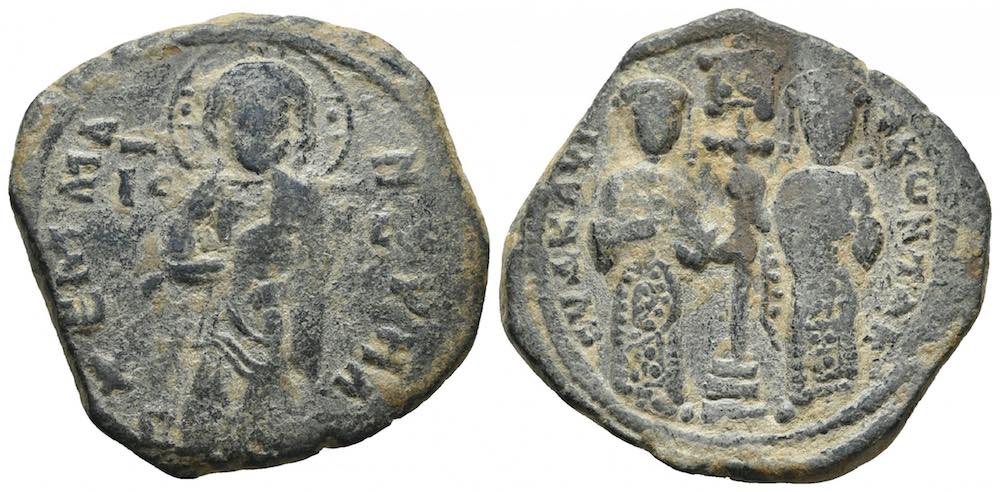 Constantine X, Ducas (1059-1067). One of only two copper types. Sear 1853.
Constantine X, Ducas (1059-1067). One of only two copper types. Sear 1853.
This piece: 29-28 mm. 10.58 grams.
Christ standing, +ЄMMA-NOVHA around "God is with us"
Constantine X and Eudocia standing
Unusually, the reverse legend begins at 2:00:
+KωN T AK - EVΔK AVT
That is,
KωN[Σ]Τ[ΑΝΤΙΝΟΣ O] Δ[ΟY]Κ[ΑΣ] [ЄΥΔ[Ο]Κ[ΙΑ] ΑYΓ[ΟΥΣΤΟΙ] Constantine (the) Doukas, Eudocia, Augusti [or, emperors]
 Constantine X, Ducas (1059-1067). His other named copper type. Sear 1854.
Constantine X, Ducas (1059-1067). His other named copper type. Sear 1854.
This example: 27-25 mm. 8.82 grams.
Bust of Christ facing.
Half-length figure of Constantine facing, holding labarum
KωN RACIΛVCOΔOK ("R" is "B" beginning "Basileus" for "emperor," "O" is for "the", and "ΔOK" is for Ducas, his family name.
When Constantine died in 1067 the empire was under attack from all sides. He and Eudocia had three sons, but even the oldest was not old enough to be emperor alone. Eudocia became both sole empress and regent for seven months. She was pressed into marrying the general Romanus IV who acknowledged her sons as heirs. The three sons are on the obverse of the gold histamenon of Romanus IV above.
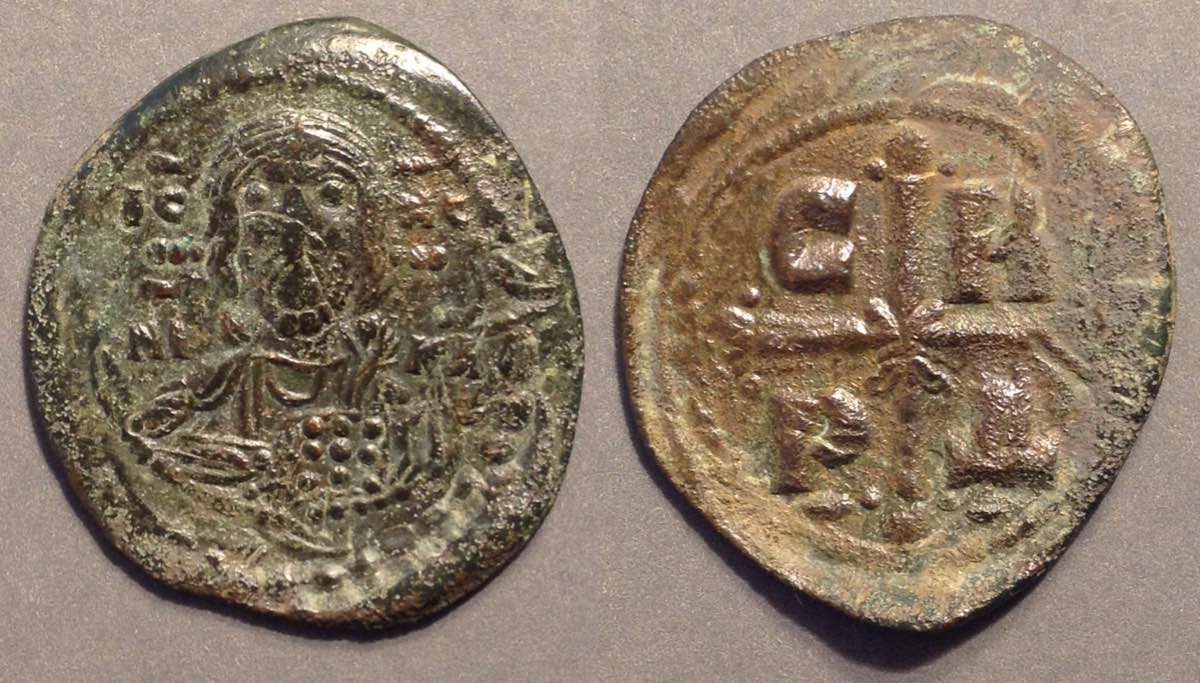 Romanus IV (1068-1071). His only named follis type.
Romanus IV (1068-1071). His only named follis type.
Sear 1866.
This example, 31-29 mm (larger than usual). 5.32 grams.
Bust of Christ facing
IC XC
NI KA in small letters either side of the head
The reverse has a square cross with
C R
P Δ (The "C" is a lunate "S" (sigma)). ΣΤAYΡЄ ΦΥΛATTЄ "O Cross, Protect
Romanus Despot/emperor" RΩMANΩ ΔЄCΠOTH
Anonymous folles of Class G are attributed to Romanus IV.
When Romanus IV lost the Battle of Manzikert he was captured by the Seljuq sultan Arp Arslan, who, after obtaining significant concessions, released Romanus to go home. It was a master stroke, splitting the Byzantines into opposing camps. The remains of the army had already promoted Michael VII, Ducas--the proper heir, the son of Constantine X we saw on the obverse of the coin of Romanus IV--to emperor not long after the battle. When Romanus was unexpectedly released and returned to Constantinople he found it already had a new emperor. Constantinople was in possession of the Ducas family of Constantine X and his young son Michael VII (who was really under the control of his advisor Psellus who wrote the extant book Fourteen Byzantine Rulers). Romanus lost his bid to reclaim the throne, was blinded, and sent to a monastary in 1078.
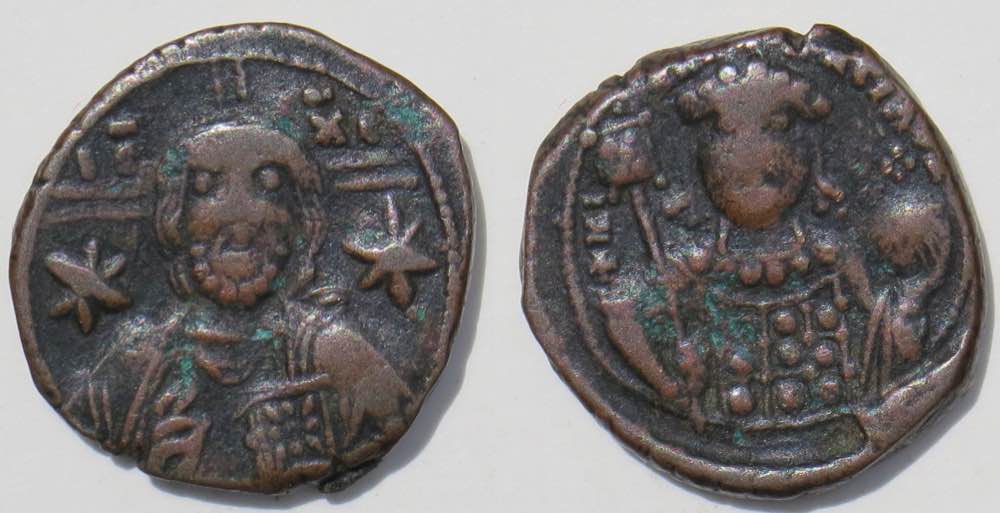 Michael VII, Ducas (1071-1078). His only named follis type. Sear 1878.
Michael VII, Ducas (1071-1078). His only named follis type. Sear 1878.
This example. 25 mm. 9.63 grams (thicker and heavier than typical)
Bust of Christ facing, IC XC either side
Large stars in each field
Facing bust of Michael VII, holding labarum and globus cruciger.
+MI-XAHΛRACIΛOΔ
Anonymous folles of Class H are attributed to Michael VII.
 Prior to the reform the most common silver denomination was the "2/3 miliaresion." It is (too) thin, often damaged or clipped, and scarce.
Prior to the reform the most common silver denomination was the "2/3 miliaresion." It is (too) thin, often damaged or clipped, and scarce.
Michael VII, Ducas (1071-1078).
21-18 mm. 1.38 grams.
The Virgin Mary facing, holding the infant Christ
Legend in five lines: +ΘKЄ/ROHΘЄI/MIXAHΛ/ΔЄCPOTH/TωΔɣKA
Sear 1876.
Nicephorus III (1078-1081) successfully rebelled against Michael VII who retired to a monastary. Two revolts against Nicephorus were put down by his general Alexius Comnenus, but when Alexius' brother in law revolted Alexius marched with him to Constantinople and Nicephorus wisely retired to a monastary and Alexius took the throne as the first of the long and largely successful Comnenid dynasty.
 Nicephrous III, Botaniates (1078-1081). His only named follis type.
Nicephrous III, Botaniates (1078-1081). His only named follis type.
Sear 1888.
This example: 23-22 mm. 5.55 grams.
3/4 length figure of Christ, IC XC either side, stars in fields
C Φ (The "C" is a lunate "S" (sigma).) ΣΤAYΡЄ ΦΥΛATTЄ "O Cross, Protect"
N Δ "Nicephorus [III] Despot/emperor" NIKHΦωPON ΔЄCΠOTH
Anonymous folles of Class I are attributed to Nicephorus III.
Nicephorus III was followed by Alexius I whose copper coins were discussed above.
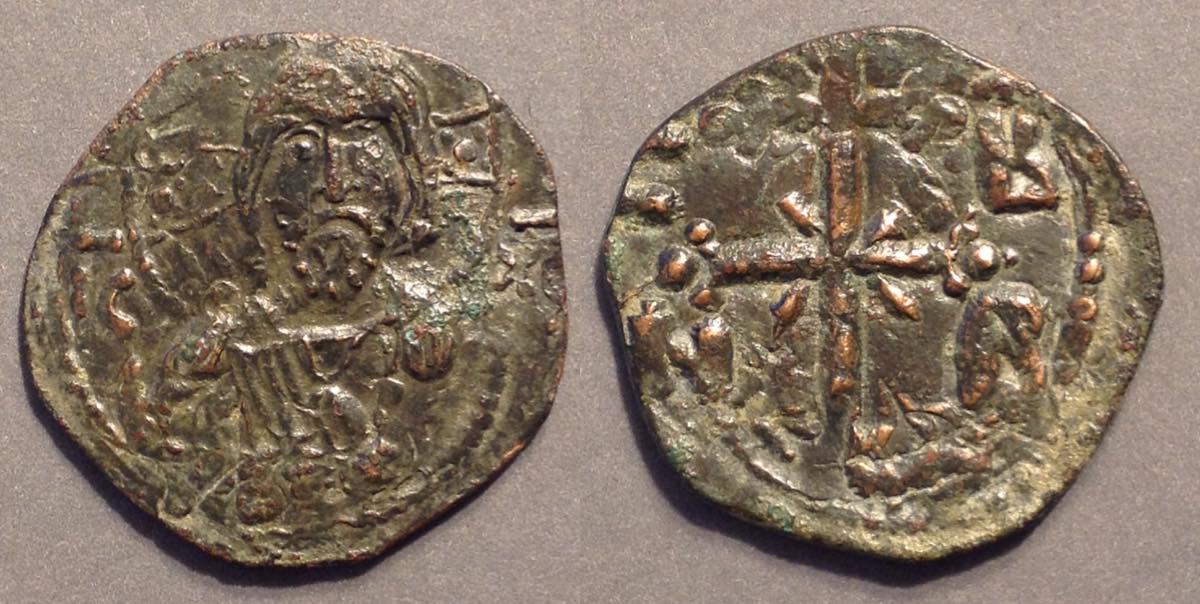 Nicephrous Bryennius (May - July 1078). One of the usurpers during the reign of Nicephorus III. The attribution of this type has been uncertain for decades. Now Kevin Parsons argues it was struck in under Nicephorus Bryennius.
Nicephrous Bryennius (May - July 1078). One of the usurpers during the reign of Nicephorus III. The attribution of this type has been uncertain for decades. Now Kevin Parsons argues it was struck in under Nicephorus Bryennius.
Sear 1890 (attributed there to Nicephorus Basilacius).
This example: 26-24 mm. 4.18 grams.
Bust of Christ facing, IC XC either side
Elaborate patriarchal cross with X at center and
C B
N B in its quadrants.
Formerly thought (by Hendy and Sear) to be of the other usurper named Nicephorus, Nicephorus Basilacius, but Grierson argued it was of Bryennius and the recent work of Parsons confirms it.
This type was considered extremely rare until c. 2018 when examples began to appear on the market.
Aside: The emperor Nicephorus Botaniates and the two usurpers Nicephorus Basilacius and Nicephorus Bryennius all had initials "NB". This coin, with "NB" in the lower quadrants is not explict about which one it is. Arguments about its attribution took into account findspots and overstrikes.
History of Byzantine gold coins. The quality of the gold in Byzantine "gold" coins declined from nearly pure (24 carats) to about 7 carats fine in the 50 years prior the reform of Alexius. Here is a simplified history of the gold coinage up to the reform.
- 315-963. The gold solidus remained essentially unchanged in size and purity of gold from its introduction by Constantine c. 315 until Nicephorus II (963-969).
- 963 ff Nicephorus II made two gold denominations to replace the solidus. One, the "histamenon nomisma" or just "histamenon," had the gold value of a solidus but soon became larger in diameter and thinner--of "spread fabric." It began c. 21 mm, but became 23 mm and then 26 mm in the next reign, Basil II (969-1025).
The second gold denomination maintained the diameter and appearance of a solidus but was thinner and lighter. We might call it a light-weight solidus. It is called the "tetarteron nomisma" or just "tetarteron" and is still c. 20 mm. The word "tetarteron" means "a fourth part," which refers to the standard weight reduced by one fourth of a temissis, so the new tetarteron is valued at only 11/12 of a solidus. (Later the term "terarteron" refers to something much different--a small copper denomination introduced by Alexius I.) In spite of their similar gold values, both denominations continued to be issued until the reform of Alexius I in 1092.
- 1030s The gold coins remained close to pure until Michael IV (1034-1041), when an initial drop to 20 carats began a 50-year decline to c. 7 carats. Also, the histamenon began to be slightly cup-shaped. When coins are cup-shaped we use the term "trachy" (sometimes "concave") to describe the shape, modified by the the name of the denomination or the metal (e.g. "Billon aspron trachy").
- 1092 Alexius I (1081-1118) reformed the coinage. The copper follis and old electrum denominations were discontinued and new denominations issued.
Next are gold coins with more details about their types.
 Romanus IV (1068-1071) histamenon. [Also illustrated above]
Romanus IV (1068-1071) histamenon. [Also illustrated above]
28-24 mm and 4.28 grams.
The obverse legend abbreviates their names, KωN at 8:00 for Constantius, MX at 1:00 for Michael (later Michael VII) ) and ANΔ at 3:30 for Androncius (not the later emperor of that name).
The reverse shows Christ in the middle crowning Romanus on the left and Eudocia on the right. The legend is
PωMAN ЄVΔKIA for Romanus and Eudocia.
Sear 1861.
 Michael VII (1071-1078) histamenon.
Michael VII (1071-1078) histamenon.
28 mm. 4.24 grams. Slightly clipped as can be seen 11:00-1:30 on the obverse.
Bust of Christ facing. IS XC either side. No legend.
Michael VII facing, holding labarum and globus cruciger.
+MIX -AHΛ-bACIΛOΔ
"Michael, Emperor, Despot"
He was a minor when he became emperor. The coin portrait makes him look older than he was.

Alexius I (1078-1118) hyperpyron. [Also illustrated above]
Sear 1913.
This example: 31 mm. 4.34 grams.
Christ seated facing, holding gospels in his left and right hand raised in benediction.
+KERO-HΘЄI
Alexius I standing (vertically exaggerated) with elaborate imperial robes with greatly exaggerated jewels. He holds labarum and globus cruciger.
Legend either side:
A Tω
ΛЄ KO
ZIω MH
ΔЄC Nω
ΠO
TH
"Alexius, Despot, Komnenus"
References: (In order of importance to this topic)
Byzantine Coins and their Values, second edition, 1987, by David Sear.
Catalogue of the Byzantine coins in the Dumbarton Oaks Collection and in the Whittemore Collection, volumes 3 (1973) and 4 (1999). Alexius I is in volume 4, part 1, pages 181-243, with plates I-VII in volume 4, part 2. Constantine X through Nicephorus III are in volume 3, part 2, which includes both text and plates.
Byzantine Coins, by Philip Grierson. 1982. Alexius I is discussed on pages 211-228 with images on plates 59-62.
Fourteen Byzantine Rulers, by Michael Psellus (1018-1096) translated by K.R.A. Sewter, in the Penguin Classics series. 1966. A primary ancient source.
A Short History of Byzantium, by John Julius Norwich. 1997. A very entertaining 431-page condensation of his three-volume series on Byzantium. I recommend this shorter version for beginners and the longer version if you become more interested. Unlike many other history books on the Byzantine empire, this one focuses on stories about the emperors, with less on administration, the Church, organization of the army, and structure of the government. In other words, it is just what coin collectors want!
Hendy, Michael. Coinage and Money in the Byzantine Empire, 1081-1261. 1969. 453 pages, 51 plates, and two large pull-out maps. Pages 1-101 cover the monetary crisis through the reform coins of Alexius I.
Papadopoulou, Pagona. "The big problem of small change in the Byzantine world (12th-13th centuries)." The First International Byzantine Studies Symposium, Proceedings. 2010.
Parsons, Kevin. 2022. Manuscript under review.
After I posted about Alexius to CoinTalk, there were several interesting replies.
Return to the page "Introduction to Byzantine coins."
Contact me at 
 The Coin Reform of the Byzantine Emperor Alexius I, 1081-1118.
The Coin Reform of the Byzantine Emperor Alexius I, 1081-1118. 
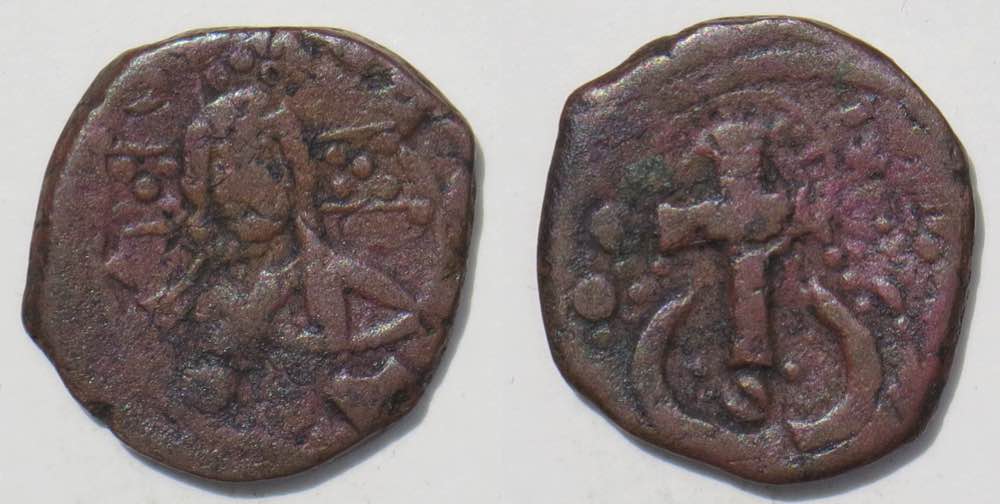
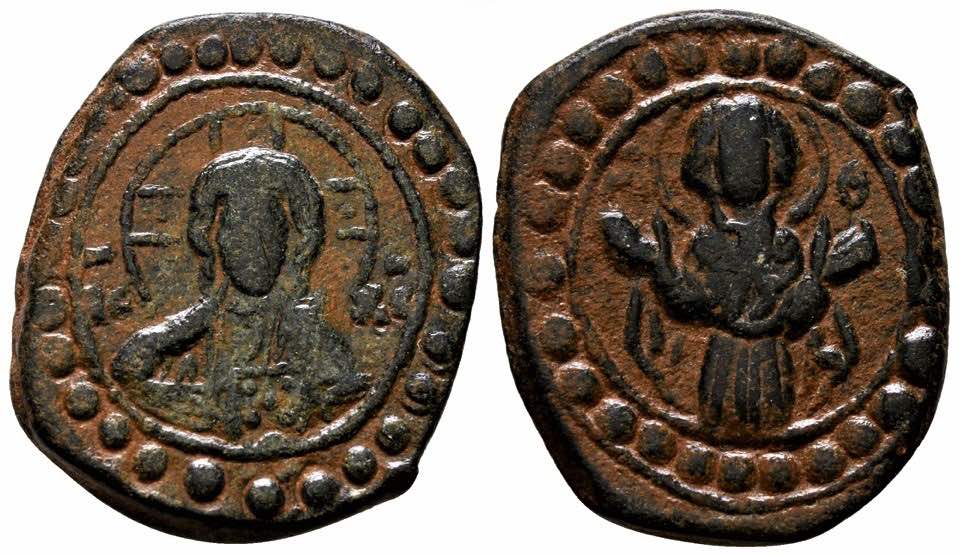
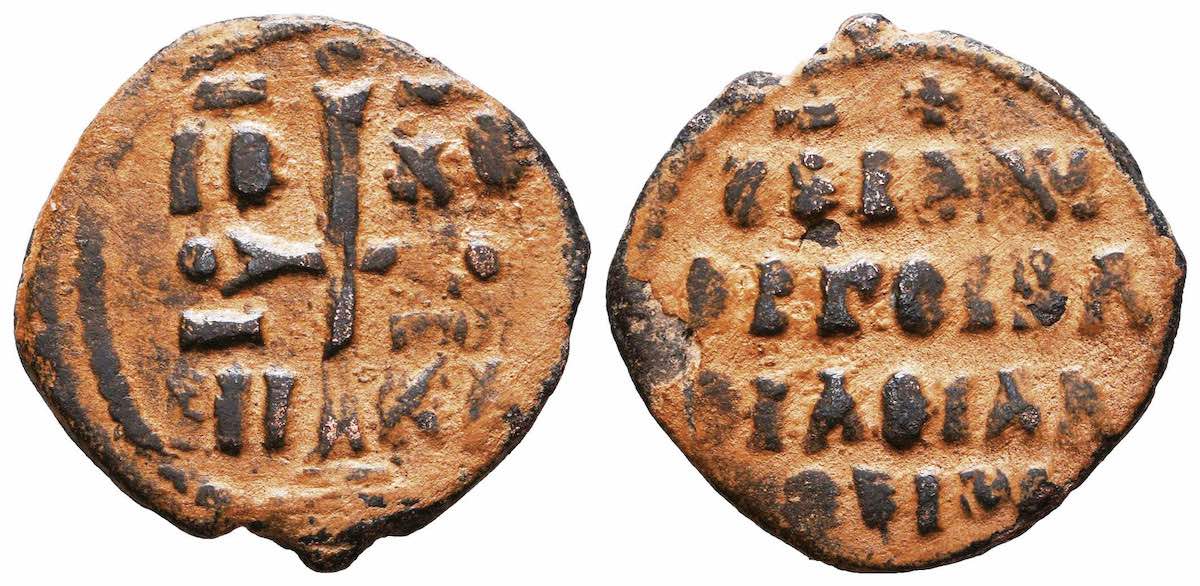
 This piece: 25-23 mm. 3.68 grams.
This piece: 25-23 mm. 3.68 grams.

 Here is a second, common, type of the new tetarteron
Here is a second, common, type of the new tetarteron Constantine X, Ducas (1059-1067). One of only two copper types. Sear 1853.
Constantine X, Ducas (1059-1067). One of only two copper types. Sear 1853. Constantine X, Ducas (1059-1067). His other named copper type. Sear 1854.
Constantine X, Ducas (1059-1067). His other named copper type. Sear 1854.
 Michael VII, Ducas (1071-1078). His only named follis type. Sear 1878.
Michael VII, Ducas (1071-1078). His only named follis type. Sear 1878. Prior to the reform the most common silver denomination was the "2/3 miliaresion." It is (too) thin, often damaged or clipped, and scarce.
Prior to the reform the most common silver denomination was the "2/3 miliaresion." It is (too) thin, often damaged or clipped, and scarce.  Nicephrous III, Botaniates (1078-1081). His only named follis type.
Nicephrous III, Botaniates (1078-1081). His only named follis type. Nicephrous Bryennius (May - July 1078). One of the usurpers during the reign of Nicephorus III. The attribution of this type has been uncertain for decades. Now Kevin Parsons argues it was struck in under Nicephorus Bryennius.
Nicephrous Bryennius (May - July 1078). One of the usurpers during the reign of Nicephorus III. The attribution of this type has been uncertain for decades. Now Kevin Parsons argues it was struck in under Nicephorus Bryennius.  Michael VII (1071-1078) histamenon.
Michael VII (1071-1078) histamenon.